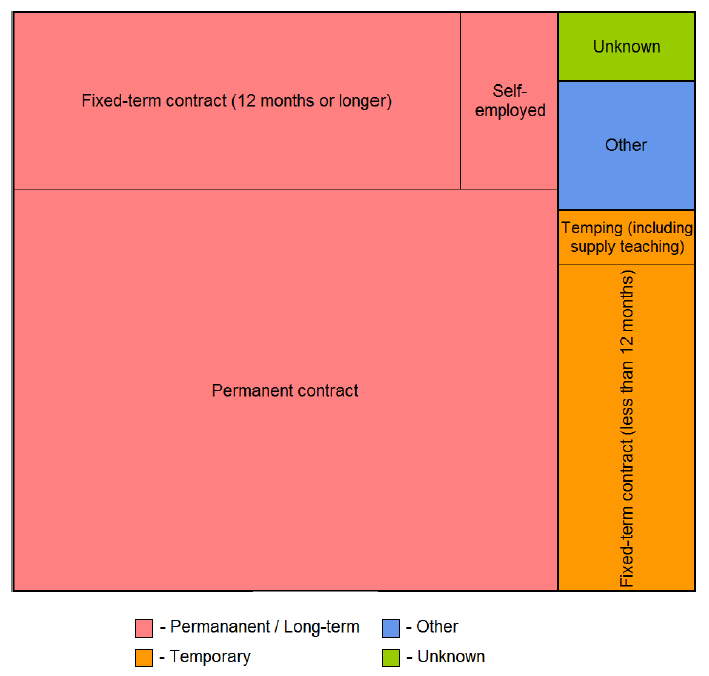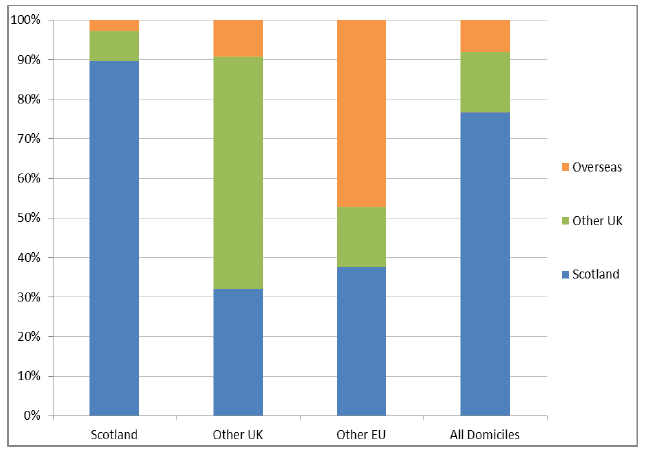Early Destinations of Students Qualifying from Scottish Higher Educations Institutions 2012-13
Statistics on the first destinations of leavers from Scottish Higher Education Institutions (HEIs)in 2012-13
2. Leavers from Scottish HEIs in Employment
2.1 Employment basis of leavers in employment
The majority of leavers in UK employment were employed on permanent contracts (55.5 per cent) with a further 20.0 per cent employed on fixed term contracts lasting 12 months or longer. Of those who found UK employment on a more temporary basis, 11.3 per cent were employed on fixed term contracts lasting less than 12 months and a further 1.9 per cent were temping. (Table 3, Figure 6).
Figure 6: Employment basis of leavers from Scottish HEIs: 2012-13

Source: Higher Education Statistics Agency (HESA)
'Other' includes those doing voluntary work, on an internship or developing a professional portfolio/creative practice'
Reference: Table 3
Looking at employment basis by level of qualification obtained we see that the lower the level of qualification obtained, the higher the percentage of leavers employed on permanent contracts (Table 3). Therefore, while employment rates are higher for leavers with higher qualifications (Table 1), they are more likely to be employed on a temporary/fixed-term basis (Table 3).
2.2 Occupation of leavers in employment
The occupations of leavers can be grouped using the Standard Occupational Classification (SOC). The SOC contains eight major groups with the first three groups (SOC 1 to 3) covering Managerial and Professional occupations. In 2012-13, almost three quarters of leavers (74.9 per cent) who found UK employment were employed in Managerial and Professional occupations (Table 4, Figure 7).
Figure 7: Occupation of leavers from Scottish HEIs: 2012-13

Source: Higher Education Statistics Agency (HESA)
Reference: Table 4
Looking at occupation by level of qualification obtained we see that the higher the level of qualification obtained, the higher the percentage of leavers in Managerial and Professional occupations (SOC 1 to 3) (Table 4).
2.3 Location of leavers in employment
By comparing leavers' pre-study domicile with their location of employment we can get an early indication of the flows of leavers from Scottish HEIs to other parts of the UK and overseas. The vast majority of Scottish domiciled leavers who found employment did so in Scotland (89.7 per cent). This compares with almost a third (32.0 per cent) of leavers domiciled in other parts of the UK. Of EU domiciled leavers 37.7 per cent of those who found employment did so in Scotland (Table 7, Figure 8).
Figure 8: Employment location of leavers from Scottish HEIs by pre-study domicile: 2012-13

Source: Higher Education Statistics Agency (HESA)
Reference: Table 7
Contact
Email: Lisa Bell
There is a problem
Thanks for your feedback